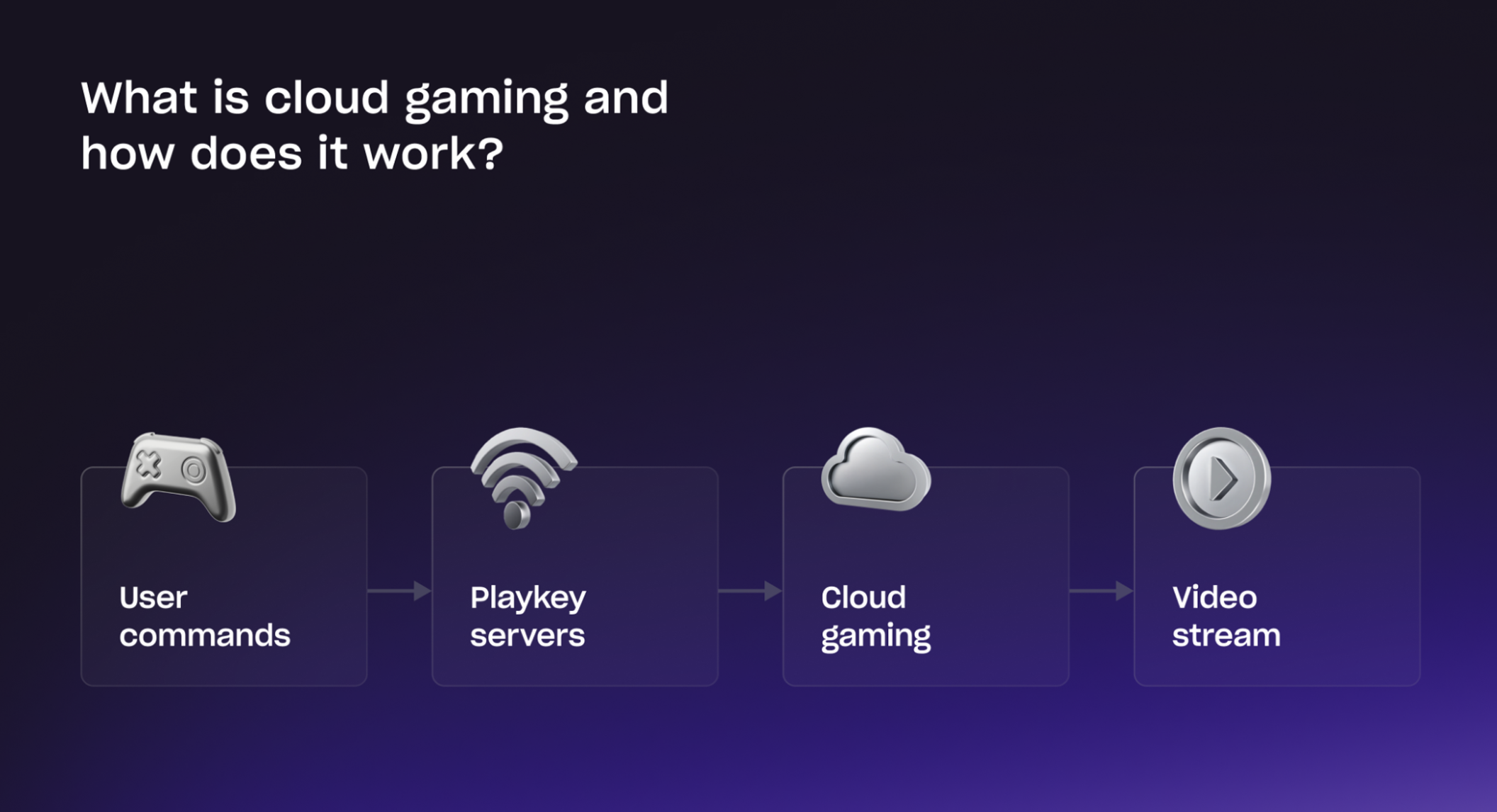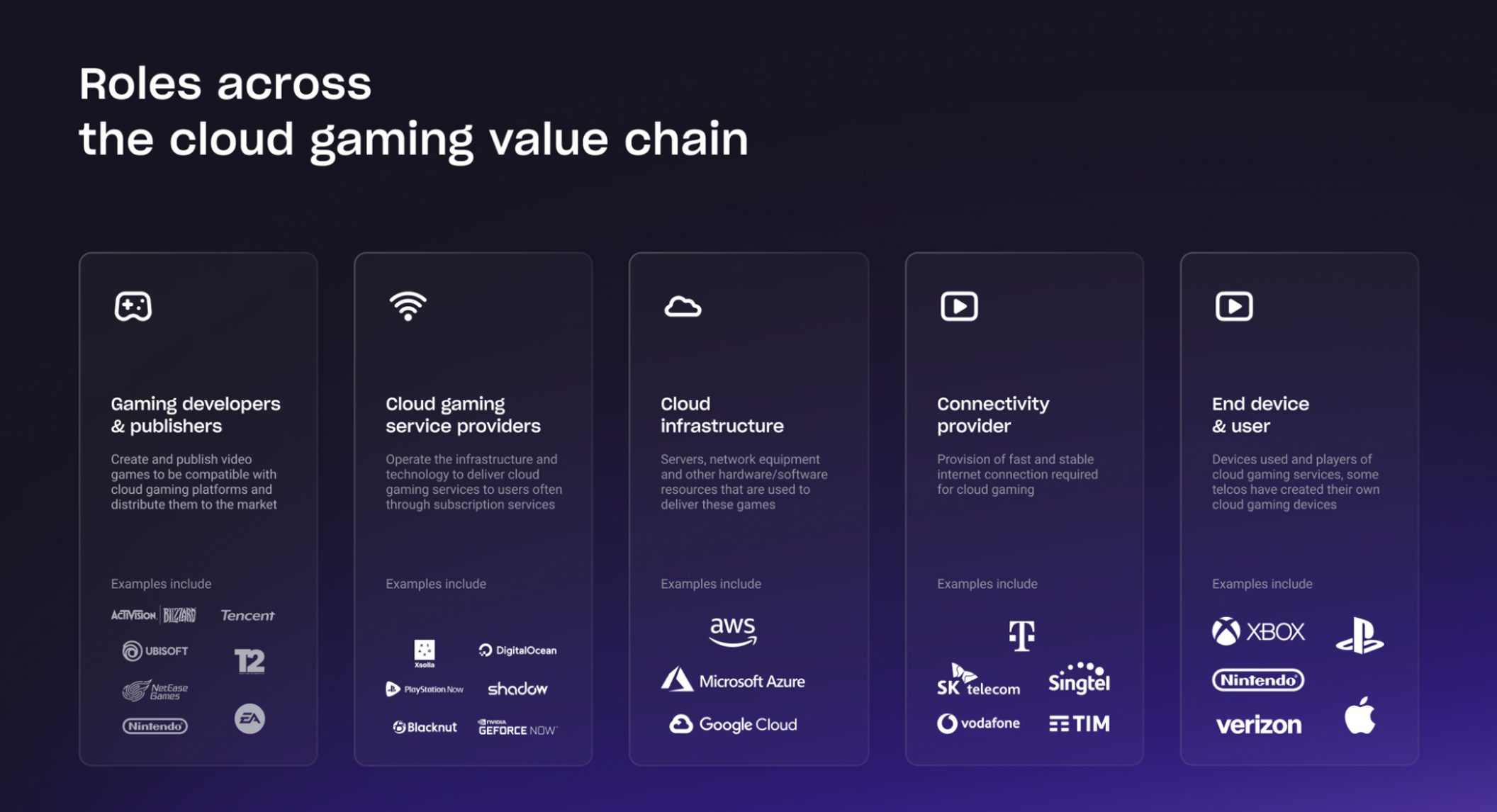Game distribution
Gaming hub
What is cloud gaming?
August 26, 2025•5 min
This three-article blog series examines Cloud Gaming in 2025: What it is, emerging trends, and what it means for gamers, developers, and game investors.

Platform holders like Sony have significantly expanded their cloud ambitions. PlayStation Plus now includes cloud streaming for many PS4 and PS5 titles, and Sony is testing direct-to-TV streaming through native apps, a move aimed at reducing dependency on hardware cycles and expanding the PlayStation brand to more devices.
How does cloud gaming work?
Cloud gaming is a method of playing video games without requiring powerful hardware at home. Instead of running the game on the player's device, the game runs on a remote server in a data center. What the player sees on the screen is a video stream of the game (on any popular browser), and their inputs, such as button presses or mouse movements, are sent back to the server. When a game begins, the server handles everything: game logic, graphics rendering, and sound processing. It then compresses the video output and streams it to the device. As play progresses, the server receives every input, then responds by updating the game and sending back a new frame. This process repeats 30 to 60 times per second to keep the experience smooth and responsive. The biggest technical challenge is minimizing lag. The delay between input and the visual response must be nearly invisible for this system to feel playable. That’s where infrastructure improvements come in. Modern cloud gaming depends heavily on fast internet, low-latency connections, and scalable server power. Technologies like 5G reduce transmission delays, while edge computing helps by running servers closer to users geographically. High-end GPUs in data centers enable complex games to run at top settings, even on devices as basic as a phone or smart TV. Cloud gaming shifts the performance burden to the cloud, opening the door for high-quality gaming on nearly any device, as long as the network can keep up.
Cloud gaming's key challenges
The gaming industry is moving steadily toward cloud-based infrastructure, but the transition isn’t smooth. Companies face several recurring challenges that can stall or undermine the benefits of adopting cloud services. Here’s a breakdown of the core issues.- Limited region availability: A single cloud vendor does not necessarily support all regions.
- Cost: Fortunately, the emergence of edge providers and decentralized GPU cloud suppliers can help to mitigate costs.
- Latency ruins the experience: Reducing latency is crucial in gaming, particularly for competitive or fast-paced titles. Even minor delays can break immersion or frustrate players. The solution sounds simple, but implementation is complex: Put servers closer to users. Companies must decide where to deploy regional servers to reduce ping times. For large-scale games, such as MMOs, this means balancing global traffic without overextending infrastructure budgets.
- Server optimization is an uphill climb: GPU-as-a-service (GPUaaS) is growing, but bandwidth remains a bottleneck. Most cloud gaming services require a minimum of 10 Mbps, while 4K streaming can demand 35 Mbps. Many users still lack consistent access to these speeds. The real-time nature of cloud gaming, characterized by constant back-and-forth between user commands and video streams, exposes weaknesses in server load balancing and network infrastructure.
- Visibility trade-offs limit control: One of the benefits of cloud computing is the ability to offload infrastructure maintenance. But that comes with a trade-off: less visibility into what’s happening under the hood. For companies new to the cloud, this lack of control makes it harder to measure system efficiency or troubleshoot problems. Selecting a provider with detailed monitoring and analytics tools is critical to closing this gap.
- Incompatibility can stall momentum: Mismatches between legacy systems and new services can cause costly delays or force businesses to switch providers mid-project when migrating to the cloud. Compatibility checks should occur early; i.e., cataloging all assets and verifying with the cloud provider that they’ll function properly post-migration.
- Downtime derails productivity: Cloud services rely on a reliable internet connection. Teams can’t access tools without it, and players suffer from lag or service interruptions. In areas with unstable connections, downtime isn’t a possibility; it’s a guarantee. Companies must assess their network strength before making the leap or risk constant disruptions.
Key players and shifting power
Cloud gaming is no longer a side project or a bet on the future; it has become a mainstream reality. It’s a core part of how the industry operates, with major companies treating it as a primary distribution model, not just a novelty. The players dominating this space fall into two groups: tech giants that build the platforms, and publishers that try to control how their games reach players. Cloud Gaming is now center stage. Game publishers are actively incorporating cloud gaming into their game release cycle strategy as a means to reach a broader audience. Ubisoft has been one of the most aggressive publishers in this space. Ubisoft+ gives players access to the company’s full game library through a single subscription, and it’s already integrated with services like Amazon Luna and Xbox Cloud Gaming. Ubisoft wants ubiquity. It’s focused on availability across as many platforms as possible, even if that means working with competitors. Electronic Arts is moving in the same direction, bundling EA Play into larger ecosystems like Game Pass and offering cloud-ready games through partner platforms. It's been a while since EA launched its standalone cloud service tests, but its strategy is clear: prioritize distribution and accessibility over exclusivity. Microsoft Game Studios has announced that it will simultaneously release all new game releases on the cloud.Platform holders like Sony have significantly expanded their cloud ambitions. PlayStation Plus now includes cloud streaming for many PS4 and PS5 titles, and Sony is testing direct-to-TV streaming through native apps, a move aimed at reducing dependency on hardware cycles and expanding the PlayStation brand to more devices.

What's next?
The cloud gaming landscape in 2025 is rapidly evolving, and several key trends are worth understanding, including control over distribution, ownership of content flow, pricing models, game ownership, and long-term sustainability. We cover these and other cloud gaming topics in our next blog post, "Emerging trends shaping the future of cloud gaming". If your company is ready to expand its audience and improve retention immediately, schedule a meeting with an Xsolla expert or create a Publisher Account to give players worldwide the gift of your game with Xsolla Cloud Gaming today.Contact us
Talk to an expert
Ready to maximize revenue opportunities? Reach out to our experts and learn how to start earning more and spending less.